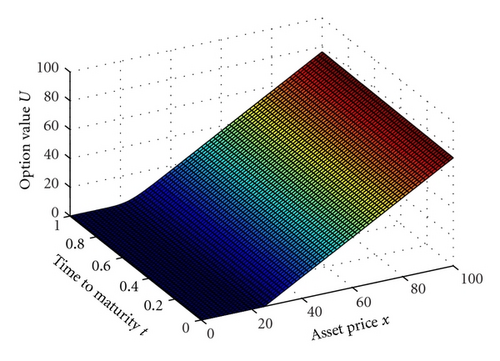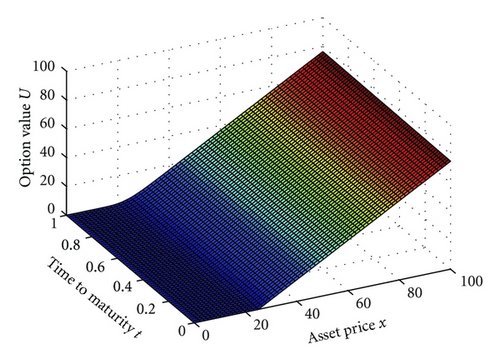Exponential Time Integration and Second-Order Difference Scheme for a Generalized Black-Scholes Equation
Abstract
We apply an exponential time integration scheme combined with a central difference scheme on a piecewise uniform mesh with respect to the spatial variable to evaluate a generalized Black-Scholes equation. We show that the scheme is second-order convergent for both time and spatial variables. It is proved that the scheme is unconditionally stable. Numerical results support the theoretical results.
1. Introduction
The pricing and hedging of derivative securities, also known as contingent claims, is a subject of much practical importance. One basic type of derivative is an option. The owner of a call option has the right but not the obligation to purchase an underlying asset (such as a stock) for a specified price (called the exercise price or strike price) on or before a expiry date. A put option is similar except the owner of such a contract has the right but not the obligation to sell. Options which can be exercised only on the expiry date are called European, whereas options which can be exercised any time up to and including the expiry date are classified as American. It was shown by Black and Scholes [1] that these option prices satisfy a second-order partial differential equation with respect to the time horizon t and the underlying asset price x. This equation is now known as the Black-Scholes equation and can be solved exactly when the coefficients are constant or space-independent. However, in many practical situations, numerical solutions are normally sought. Therefore, efficient and accurate numerical algorithms are essential for solving this problem accurately.
The Black-Scholes differential operator at x = 0 is degenerate. A common and widely used approach by many authors dealing with finite difference/volume/element methods for the Black-Scholes equation is to apply an Euler transformation to remove the degeneracy of the differential operator when the parameters of the Black-Scholes equation are constant or space independent, see for example [2–7]. As a result of the Euler transformation, the transformed interval becomes (−∞, ∞). However, the truncation on the left-hand side of the domain to artificially remove the degeneracy may cause computational errors. Furthermore, the uniform mesh on the transformed interval will lead to the originally grid points concentrating around x = 0 inappropriately. Moreover, when a problem is space-dependent, this transformation is impossible, and thus the Black-Scholes equation in the original form needs to be solved.
It is well known that when using the standard finite difference method to solve those problems involving the convection-diffusion operator, such as the Black-Scholes differential operator, numerical difficulty can be caused. The main reason is that when the volatility or the asset price is small, the Black-Scholes differential operator becomes a convection-dominated operator. Hence, the implicit Euler scheme with central spatial difference method may lead to nonphysical oscillations in the computed solution. The implicit Euler scheme with upwind spatial difference method does not have this disadvantage, but this difference scheme is only first-order convergent [8]. Recently, a stable fitted finite volume method [9] is employed for the discretization of the Black-Scholes equation. But it is also first-order convergent. In [10, 11] numerical methods of option pricing models are studied by applying a standard finite volume method to obtain a difference scheme. Their numerical schemes use central difference for a given mesh, but switch to upstream weighting for a small number of nodes, which are second-order spatial convergent. In this paper we change the grid spacing to a piecewise uniform mesh which is constructed so that central difference is used everywhere.
For time discretization, explicit schemes are easy to implement but suffer from stability problems. Some well-known second-order implicit schemes, such as Crank-Nicolson method, are prone to spurious oscillations unless the time step size is no more than twice the maximum time step size for an explicit method (see Zvan et al. [10, 11]). Although the fully implicit backward Euler method may be used to accurately solve the Black-Scholes PDE due to its strong stability properties, it is only first-order accurate in time. Exponential time integration has gained importance following the work of Cox and Matthews [12] and with recent developments in efficient methods for computing the matrix exponential [13–16], this time evolution method is likely to be a popular choice for solving large semidiscrete systems arising in various numerical computations.
In [17, 18], we have presented robust difference schemes for the Black-Scholes equation, which is based on the implicit Euler method for time discretization and a central difference method for spatial discretization. In this paper, we apply an exponential time integration scheme combined with a central difference scheme on a piecewise uniform mesh with respect to the spatial variable. We show that our scheme is second-order convergent for both time and spatial variables, while in [17, 18] the convergence for the time variable is only first order. It is proved that the scheme is unconditionally stable. Numerical results support this conclusion.
The rest of the paper is organized as follows. In the next section we discuss the continuous model of the Black-Scholes equations. The discretization method is described in Section 3. It is shown that the finite difference scheme is second-order convergent with respect to both spatial and time variables. In Section 4 we prove that the difference scheme is unconditionally stable. Finally numerical examples are presented in Section 5.
2. The Continuous Problem
Even though as x goes to zero the generalized Black-Scholes operator (2.1) is degenerate, the existence and uniqueness of a solution of (2.1)–(2.3) is well known. Due to the fact that the initial condition is not smooth, the finite difference scheme may not converge to the exact solution.
3. Discretization Scheme
The exponential time differencing scheme is an approach used for the numerical solution of a wide range of PDEs that involve spatial variables as well as a time variable. The spatial discretization results in an approximating system of ODEs. For an inhomogeneous linear PDE, this method leads to an inhomogeneous linear system of ODEs in time whose solution satisfies a two-term recurrence relation involving the matrix exponential, where the matrix is determined by the form of spatial discretization applied such as finite difference, finite element, or spectral approach. In this paper we use a central difference scheme on a piecewise uniform mesh for approximating the spatial derivatives.
Lemma 3.1. For each t the matrix A(t) is strictly diagonally dominant.
Proof. It is easy to see that
It can be seen that the truncation error of the difference scheme (3.17) with is O(h2 + l2) (see [21], e.g.).
4. Stability Analysis
Lemma 4.1. For each t the real part of each nonzero eigenvalue of A(t) is negative.
Proof. From Lemma 3.1 we can obtain that for each t the matrix −A(t) is an M-matrix, thus the real part of each nonzero eigenvalue of −A(t) is positive (see [23, Theorem 3.1]). Hence the real part of each nonzero eigenvalue of A(t) is negative.
Theorem 4.2. The difference scheme (3.17) is unconditionally stable.
Proof. Let λi (i = 1,2, …, N − 1) be eigenvalues of matrix A(t) for a fixed t, then
5. Numerical Experiments
In this section we verify experimentally the theoretical results obtained in the preceding section. Errors and convergence rates for the numerical scheme are presented for two test problems.
Test 1 European call option with parameters: σ = 0.2 + 0.2(1 − t)((x/25 − 1.2) 2/((x/25) 2 + 1.44))) , r = 0.06, T = 1, K = 25 and Smax = 100.
Test 2 European call option with parameters: σ = 0.2[1 + 0.1(1 − t)(x/(1 + x))], r = 0.06, T = 1, K = 25 and Smax = 100.
For Tests 1 and 2 we choose of the rational approximation (3.17). The computed option value U with N = M = 64 are depicted in Figures 1 and 2, respectively.


| M | N | Exponential method | Implicit Euler method | ||
|---|---|---|---|---|---|
| Error eN,M | Rate rN,M | Error eN,M | Rate rN,M | ||
| 16 | 64 | 1.2535e − 1 | — | 1.7817e − 1 | — |
| 32 | 128 | 2.9268e − 2 | 2.099 | 8.9567e − 2 | 0.992 |
| 64 | 256 | 1.5725e − 2 | 0.896 | 4.6822e − 2 | 0.936 |
| M | N | Exponential method | Implicit Euler method | ||
|---|---|---|---|---|---|
| Error eN,M | Rate rN,M | Error eN,M | Rate rN,M | ||
| 16 | 64 | 1.0716e − 1 | — | 1.7428e − 1 | — |
| 32 | 128 | 2.4716e − 2 | 2.116 | 8.9504e − 2 | 0.961 |
| 64 | 256 | 1.5810e − 2 | 0.645 | 4.7780e − 2 | 0.906 |
From the figures it is seen that the numerical solutions by our method are nonoscillatory. We compare the accuracy of the exponential time integration method with the implicit Euler method in [17]. From Tables 1 and 2 we can see the exponential time integration method converges more rapidly than the implicit Euler method in [17], but for the same M and N the exponential time integration method require more computer time than the implicit Euler method. We also can see that rN,M of the exponential time integration method is close to 2, even though this rate is not reached for large M and N, the reason is that the “exact solution” is not really the exact solution. Therefore the numerical results support the convergence estimate of Theorem 4.2.
Acknowledgments
The authors would like to thank the anonymous referee for several suggestions for the improvement of this paper. The work was supported by Zhejiang Province Natural Science Foundation (Grant nos. Y6100021, Y6110310) of China and Ningbo Municipal Natural Science Foundation (Grant no. 2010A610099) of China.




